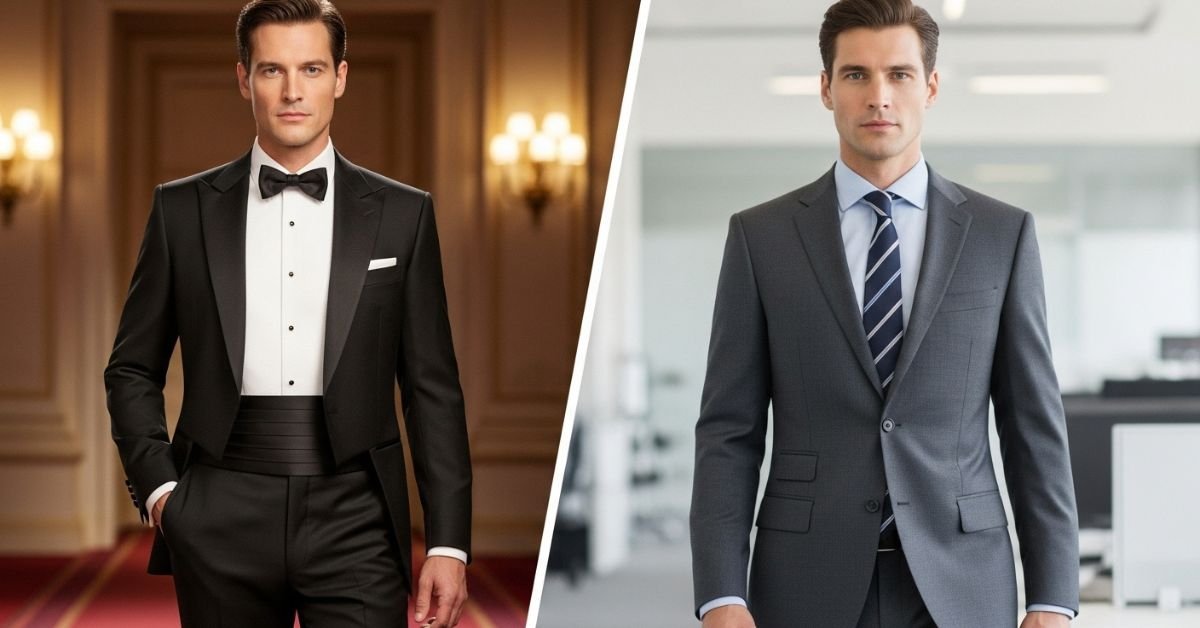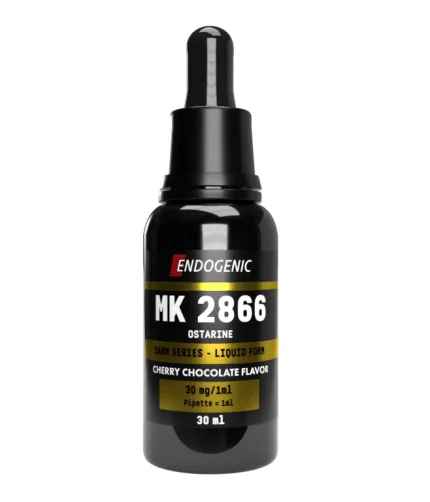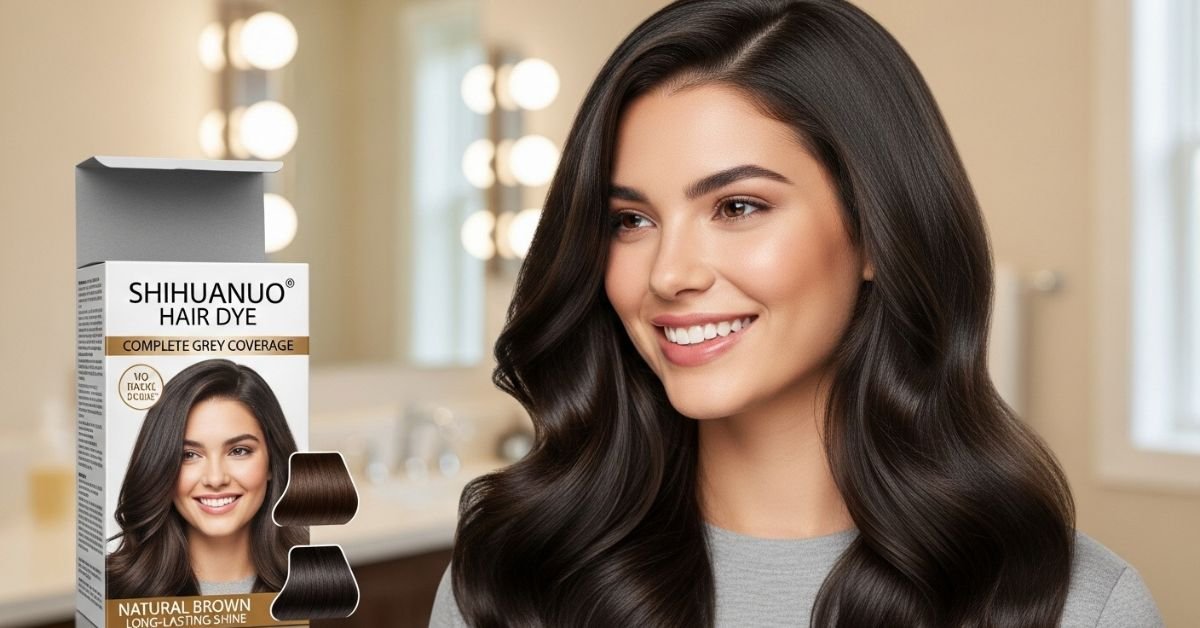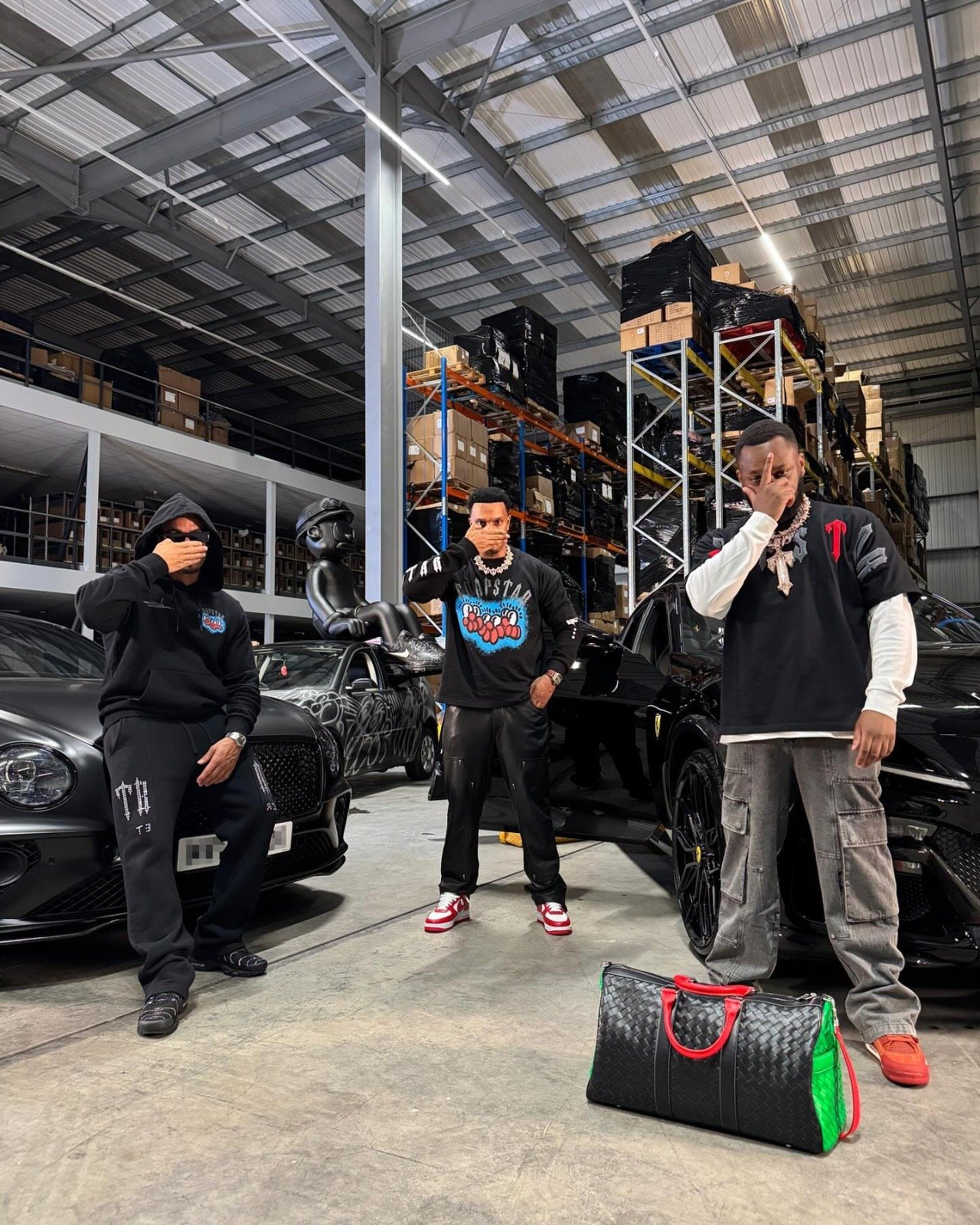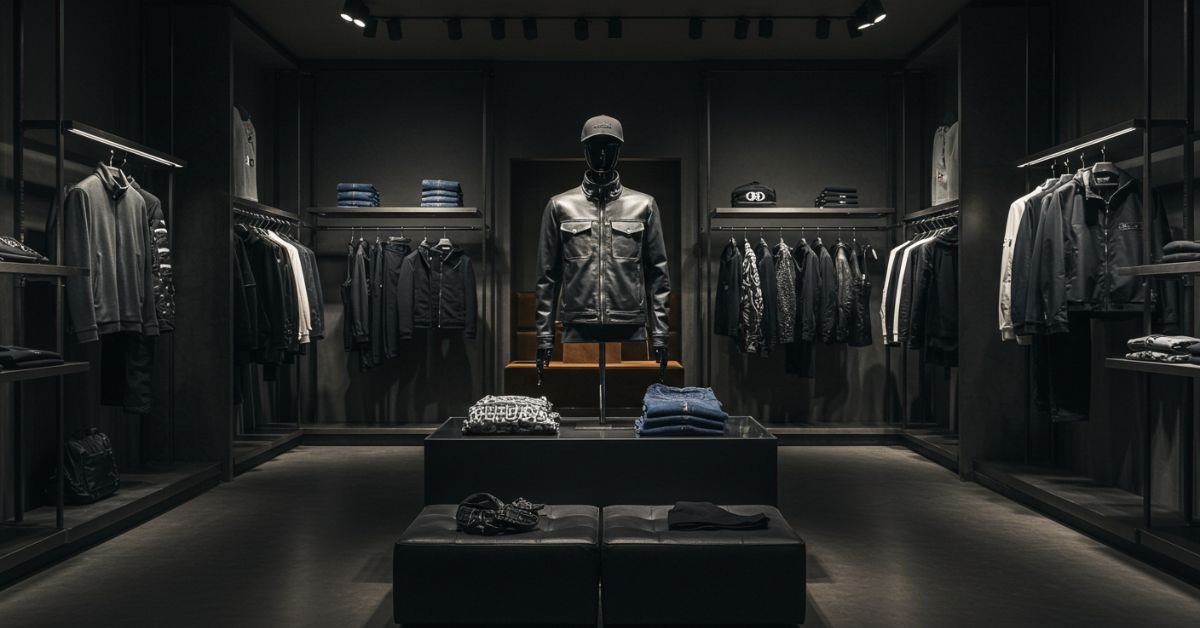Contents
- 1 Introduction
- 2 Dinner Suit vs Business Suit: The Core Difference
- 3 The History Behind Each Suit
- 4 Fabric and Material Differences
- 5 Color and Style Variations
- 6 Lapels and Jacket Design
- 7 Shirt Choices
- 8 Accessories: Bow Tie vs Necktie
- 9 Footwear Differences
- 10 When to Wear Each Suit
- 11 Common Mistakes to Avoid
- 12 Visual Guide: Spotting the Difference
- 13 FAQs About Dinner Suits and Business Suits
- 13.1 Can you wear a dinner suit as a business suit?
- 13.2 Can a business suit double as a dinner suit?
- 13.3 What’s the main difference between tuxedo trousers and business trousers?
- 13.4 Is a bow tie required with a dinner suit?
- 13.5 Can women wear dinner suits and business suits?
- 13.6 Should a dinner suit be tailored differently than a business suit?
- 14 Conclusion
Introduction
A suit is more than clothing—it’s a statement. Whether you’re attending a black-tie gala or preparing for a corporate meeting, the suit you choose communicates professionalism, style, and respect for the occasion. But here’s where confusion often arises: what’s the difference between a dinner suit and a business suit?
These two styles share similarities, yet they serve very different purposes. Wearing the wrong one can either underdress or overdress you for the occasion. To help you choose wisely, this guide breaks down the distinctions in fabric, design, accessories, and etiquette. By the end, you’ll not only know how to tell them apart but also when and how to wear each with confidence.
Dinner Suit vs Business Suit: The Core Difference
At the heart of it, the dinner suit (often called a tuxedo) is formal evening wear, while the business suit is professional daytime wear. This is the fundamental difference. Dinner suits are tied to events where elegance is required—black tie dinners, galas, weddings, and red-carpet occasions. Business suits, on the other hand, dominate boardrooms, presentations, and office environments.
The contrast extends beyond context. Dinner suits feature luxurious details like satin lapels and silk-trimmed trousers, while business suits favor practicality, comfort, and subtlety. Wearing a dinner suit to a board meeting will feel as misplaced as showing up to a wedding reception in a plain office suit.
Simply put, one is designed to impress socially, the other to command respect professionally. Both demand attention to detail, but each plays its role in a different arena of life.
The History Behind Each Suit
The Origins of the Dinner Suit
The dinner suit, or tuxedo, emerged in the late 19th century as a fashionable alternative to the tailcoat. Aristocrats wanted evening wear that was formal yet more relaxed than traditional attire. Over time, it became the signature look for black-tie events, associated with elegance and exclusivity. Hollywood further popularized it through stars like Cary Grant and James Bond, cementing its timeless appeal.
The Evolution of the Business Suit
The business suit traces its roots back to 19th-century England, evolving from aristocratic lounge suits into the everyday professional uniform. By the 20th century, it became synonymous with corporate identity and authority. Unlike the dinner suit, its function was never about glamour but practicality—ensuring the wearer looked polished without being overly flamboyant. Its adaptability has made it the standard across industries worldwide.
Fabric and Material Differences
Dinner Suit Fabrics
Dinner suits lean on luxury fabrics—wool, barathea, and sometimes velvet. The lapels are faced with satin or grosgrain silk, and trousers often have a silk stripe running down the seam. These touches elevate the suit, ensuring it looks rich and refined under evening lighting.
Business Suit Fabrics
Business suits are built for durability and versatility. Common fabrics include worsted wool, tweed, or wool blends. The focus is on comfort and resilience, suitable for long office hours. The finish is matte, subtle, and practical rather than glossy. While patterns like pinstripes and checks are common, they are understated compared to the sleek minimalism of dinner suits.
Color and Style Variations
Dinner Suit Colors
Traditionally, dinner suits come in black or midnight blue. These shades maximize sophistication and look sharp in evening light. Occasionally, white dinner jackets appear in warm climates, but the core rule remains: dinner suits avoid loud patterns or business-like stripes.
Business Suit Colors
Business suits, by contrast, thrive on variety. Navy, charcoal, and gray are staples, with pinstripes and checks as options. Brown and lighter shades are acceptable for less formal settings. The wide range ensures professionals can maintain individuality while adhering to dress codes.
Lapels and Jacket Design
Dinner Suit Lapels
A dinner suit typically comes with peaked or shawl lapels, both faced in satin or silk. These glossy finishes instantly set them apart from everyday wear. The cut is designed to flatter, giving the wearer a sharp silhouette ideal for evening elegance.
Business Suit Lapels
Business suits mostly feature notch lapels, which are versatile and understated. Peaked lapels exist but are less common. The jacket design focuses on practicality, often with vents for comfort and freedom of movement throughout the day. Unlike the dinner suit, satin finishes are never used.
Shirt Choices
Dinner Suit Shirts
Dinner suits are paired with formal dress shirts—often white, pleated, and made of crisp cotton or pique fabric. Some include wing collars or concealed button plackets, designed specifically to complement bow ties. Studs may replace buttons for added polish.
Business Suit Shirts
Business shirts are far more versatile. White and blue dominate as base colors, but stripes and subtle patterns are also common. Collars are typically spread or point collars, accommodating ties with ease. Unlike dinner shirts, these are designed for day-long wear and practicality.
Accessories: Bow Tie vs Necktie
The Bow Tie and Dinner Suit
No dinner suit is complete without a bow tie—traditionally black, made of silk, and self-tied. The bow tie reinforces the formality of black-tie attire, maintaining the balance of tradition and elegance. Pocket squares and cufflinks may also complement the look but must remain understated.
The Necktie and Business Suit
Business suits are nearly always paired with a necktie. Solid colors, stripes, and simple patterns dominate the professional wardrobe. While ties allow for personality, they must remain appropriate to the workplace culture. Bow ties are rare in business contexts unless intentionally making a bold statement.
Footwear Differences
Dinner Suit Shoes
Dinner suits call for patent leather shoes or highly polished Oxfords. The shine matches the suit’s silk details, ensuring a cohesive and sophisticated finish. Loafers or casual shoes are never appropriate.
Business Suit Shoes
Business suits work best with leather lace-ups like Oxfords, Derbies, or brogues. They prioritize professionalism but allow for versatility—brown shoes with navy suits, black shoes with charcoal or gray. Unlike dinner suits, a subtle matte finish is the norm here.
When to Wear Each Suit
Occasions for Dinner Suits
Dinner suits are for black-tie events, weddings, galas, operas, and upscale evening functions. They should never be worn casually or during the day. The goal is elegance, not versatility.
Occasions for Business Suits
Business suits dominate professional settings—interviews, office work, client meetings, and conferences. They’re also suitable for semi-formal events, provided the invitation doesn’t specify black tie. Their flexibility makes them the everyday powerhouse of a man’s wardrobe.
Common Mistakes to Avoid
- Wearing a business suit to a black-tie event – instantly underdresses you.
- Adding satin lapels to a business suit – looks mismatched and confusing.
- Wearing a dinner suit to a business meeting – makes you appear overdressed and out of touch.
- Choosing the wrong shoes – matte shoes with a dinner suit or shiny shoes with a business suit ruin balance.
- Ignoring fit – regardless of type, poor tailoring diminishes impact.
Visual Guide: Spotting the Difference
While we can’t add images here, picture this quick comparison:
- Dinner Suit: Satin lapels, silk stripe trousers, bow tie, patent shoes, glossy finish.
- Business Suit: Matte fabric, notch lapels, necktie, leather shoes, subtle patterns.
Think of it this way: if your outfit shines, it’s likely a dinner suit. If it blends in subtly yet professionally, it’s a business suit.
FAQs About Dinner Suits and Business Suits
Can you wear a dinner suit as a business suit?
No. A dinner suit is strictly evening wear for formal events. Wearing it in a business setting appears inappropriate and overdressed.
Can a business suit double as a dinner suit?
Not ideally. Business suits lack the satin lapels and silk details required for black-tie standards. At best, it might work in a pinch for a casual evening event but won’t pass formal dress codes.
What’s the main difference between tuxedo trousers and business trousers?
Dinner suit trousers often have a silk stripe down the seam and no belt loops. Business trousers are plainer, with loops for belts and matte finishes.
Is a bow tie required with a dinner suit?
Yes. A traditional dinner suit always pairs with a bow tie. Neckties do not align with black-tie etiquette.
Can women wear dinner suits and business suits?
Absolutely. Women’s tailoring has embraced both styles, with sleek tuxedos for evening events and sharp business suits for office or professional wear.
Should a dinner suit be tailored differently than a business suit?
Yes. Dinner suits are tailored for elegance and sharper silhouettes, while business suits often prioritize comfort and movement.
Conclusion
When it comes to dressing well, knowing the difference between a dinner suit vs business suit is essential. One represents evening sophistication, the other everyday professionalism. By understanding the distinctions in fabric, color, lapels, shirts, accessories, and footwear, you’ll avoid common mistakes and always look appropriately dressed.
Ultimately, owning both ensures you’re ready for any occasion—whether it’s sealing a deal in the boardroom or celebrating at a black-tie gala. Dressing well isn’t just about style—it’s about respect for the moment.
